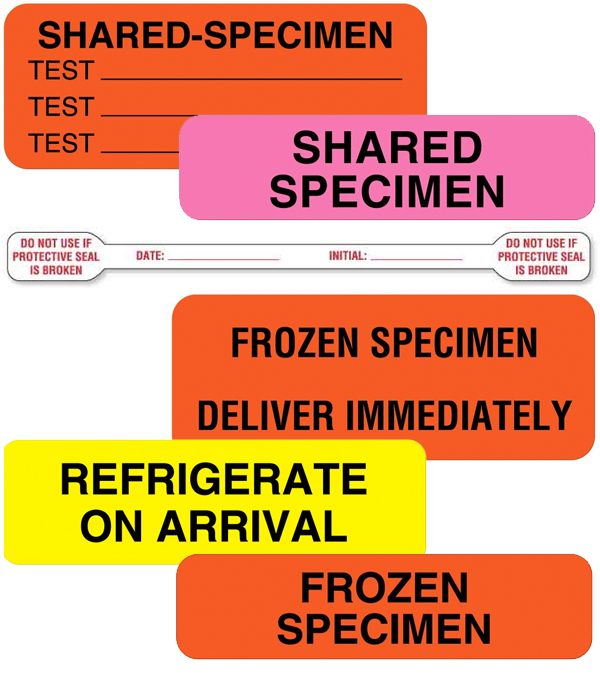How To Use Laboratory Labels To Prevent Specimen Identification Errors
Specimens inform the care team's understanding of the patient. It allows them to confirm a diagnosis and build a treatment plan. And when a fluid or tissue sample is the next step in the treatment plan, that specimen will go through each of the following steps:
- Collection
- Transport
- Processing
Although maintaining positive patient identification is the primary imperative, each step in the workflow has its own distinct challenges. And a breakdown in any of these steps can cause errors that impact patient safety, delay treatment decisions and create extra work for the care team.
Specimen Collection, Transporting And Processing
Understandably, specimen collection process improvement efforts have centered on positive patient identification such as matching two unique forms of identification. But there are common problems that manifest during this part of the process including:
- Missing patient identification
- Mismatched patient identification
- Illegible or unlabeled specimens
- Labels with wrong blood in tube (WBIT)
In addition to these identification issues, there are other collection challenges. For example, labeling blood tubes at the bedside helps ensure positive patient identification. But, to analyze a specimen properly, the fluid collected must be at a level that allows the laboratory testing equipment to draw the fluid. if the label is applied to the tube before the draw, in a way that obscures the fluid level, it increases the possibility that the fluid is not at the right level and the test will fail.
Although tissue specimens experience similar patient identification challenges, the impact of an error is greater. The complexity and expense of redrawing tissue negatively impacts the patient experience, adds to the work demands of the clinical staff and triggers additional costs.
Positively identifying the patient, applying the correct sample labels and never allowing unlabeled samples or specimens to leave the patient’s bedside or collection area prevents specimen identification errors. But, it takes proper training to ensure the labels are applied to the vial in the appropriate manner.
Specimen Transportation Challenges
Once collected, specimens get transported in a variety of ways. Within a facility, that might occur when using a pneumatic tube. Outside the facility, bio bags are a common means of shipment. In either case, a label that detaches (flags) from the test tube or vial and attaches itself to the inside of either container will compromise the specimen. In fact, it will most likely make it unusable.
The label may fail for a number of reasons.First, the laboratory label has the wrong adhesive. Instead of adhering permanently to the syringe or test tube, it comes off and reattaches to the inside of the shipping container. This may take place because:
- A supplier manufactures the label with the wrong adhesive
- The label specifications are inaccurately defined during the procurement process
In addition, changing the type of test tube or vial may cause labels to fail.For example, a label that worked perfectly on a test tube before may not work properly on a new version that contains a different plastic composition.
What’s more, even when the label material and adhesive are correct, spills in the pneumatic tube can cause it to fail. Just the sheer pressure in the pneumatic tube can cause a label to fail if not applied correctly. Although foam inserts can prevent this problem, concerns over bacteria they attract limit their use.
Lastly, the label may be applied improperly. Because the staff is rushed or is not trained on how to apply the label correctly, they leave part of the adhesive exposed. Then that exposed section attaches to the shipping container.
Specimen Processing Challenges
Whether you operate a lab internally or use one that’s outside of your facility, when a specimen arrives in the lab, laboratory labels face additional challenges. Throughout the patient journey, including the laboratory, barcodes are a key driver of patient information. For example, when a specimen is staged for analysis, the diagnostic system places it onto a conveyor where the vial passes through a barcode reader to record information about each sample. If the label is applied incorrectly or detaches during any previous step preventing a proper barcode reading, the system rejects it. Unfortunately, that usually requires the specimen to be redrawn.
How To Ensure Laboratory Labels Work Properly
Eliminating laboratory labeling problems requires a cooperative effort between supply chain, nursing and the laboratory. Decisions made independent of each stakeholder increase potential complications. Following these steps will result in better outcomes:
- Testing - when implementing a new LIS or changing label suppliers it’s essential to produce test runs that simulate actual use. This allows you to evaluate label materials and the print output. In fact, processing labels through normal workflows will prove that the materials work properly, print is legible and barcodes read accurately or uncover problems that you can assess and manage.
- Training - although applying a label likely ranks low on a nurse’s or phlebotomist’s degree of difficulty scale, there are nuances to properly labeling a specimen that aren’t obvious to the most educated medical worker. Establishing protocols and training the nursing staff on appropriate application methods will mitigate errors. Plus, performance monitoring and feedback will ensure the ongoing laboratory labeling process remains effective.
Laboratory Labels At United Ad Label
When designed, produced and executed properly, lab labels prevent specimen identification errors. United Ad Label provides compatible options for laboratory information systems including Cerner, EPIC Sunquest/MISYS, Meditech, Softlab, McKesson and more, that work effectively in direct thermal and thermal transfer printers. Each format is designed to mitigate the challenges of each step of the workflow. Contact us to learn more.



